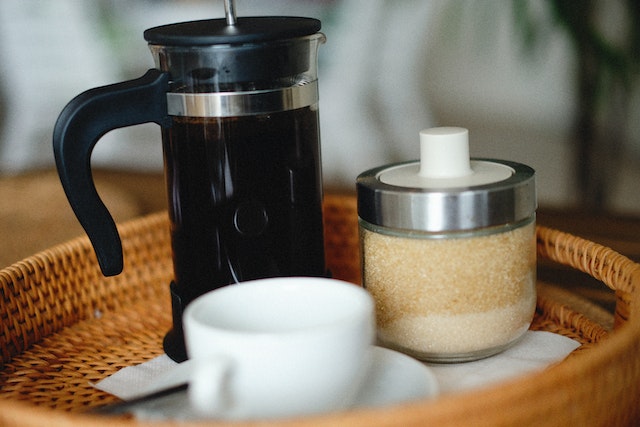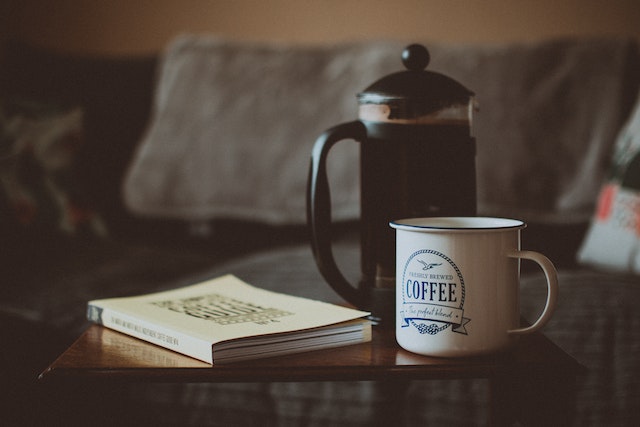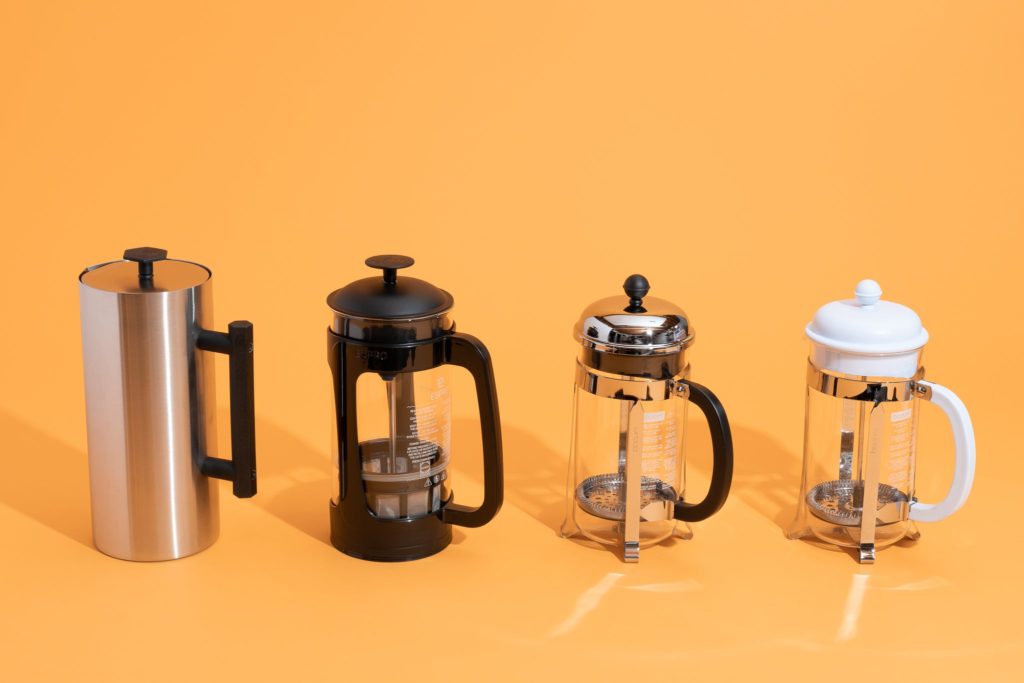Nothing quite beats the smell of freshly-brewed French press coffee in the morning. Whether you’ve been perfecting your own home brewing technique for years or are recently getting started, understanding the right ratio of grounds to water is key to a successful cup. Crafting that perfect blend can seem like something of a science; luckily, it’s easier than you think with these handy tips — we’re here to help make sure all your cups come out tasting just as amazing as they smell!
Craving a cup of delicious, rich French press coffee? Look no further! In this blog post, we’ll discuss the perfect French press coffee ratio to ensure that you are able to brew the ideal in-home cup every time. This can be achieved by accurately weighing out and measuring beans, water and other ingredients. Our experts have performed countless experiments with various ratios in order to develop an easy-to-follow guide for getting great results every single time; so, let’s get started!
Table of Contents
What Is The Ideal Water To Coffee Ratio For A French Press?
When making coffee in a French press, the ideal water to coffee ratio is one of the most important factors to consider. The right ratio can make or break your cup of joe, with too much water resulting in an over-diluted brew, and too little water leading to an overly strong, bitter taste.
Generally speaking, for every 8 oz (227 g) of water used, 1 tablespoon (7 grams) of coarsely ground coffee should be added for optimal results. This means that when using a standard 34 oz French press pot, approximately 4 tablespoons (28 grams) of loose ground beans should be added to the carafe before steeping.
It’s worth mentioning that this ratio is just a guideline and may vary depending on personal preferences and how finely or coarsely the beans are ground. Those who like their brew with more intense flavors might prefer using less water e.g., 1 tablespoon (7 g) of grounds per 6 ounces (170 g) of hot water, while those who like lighter coffees could opt for more – e.g., 2 tablespoons (14 g) per 8 ounces (227 g).

In addition to the amount of grounds used, other factors such as grind size and steep time can also affect flavor intensity and body. Finely ground beans will yield stronger tasting coffee than coarser ones; meanwhile grinding beans too fine can lead to a sludgy cup due to excessive sediment release. In terms of brew time, it takes about 3 – 5 minutes for the grounds to steep and extract proper flavors from the hot liquid – any longer than that can make it taste bitter.
With all these variables in mind, achieving great tasting French press coffee requires some experimentation – by tweaking different parameters such as grind size & amount of grounds used as well as brewing time until you get your desired result. Ultimately however, it all depends on your individual taste preference so feel free to adjust the water-to-coffee ratio accordingly!
French Press Coffee To Water Ratio Calculator
Brewing the perfect cup of French press coffee can be a tricky task. It is important to understand the correct coffee to water ratio, as this will heavily influence the flavor and strength of your beverage. Luckily, with a few helpful tips and a bit of practice, you can easily master this technique for optimal results.
When making French press coffee, the general rule of thumb for coffee to water ratio should be 1:16. This means that you should use one gram of ground coffee for every sixteen grams of water. However, if you are looking for an even stronger cup of coffee, then you may want to up the amount of ground beans per serving; a more intense brew requires more grounds per cup. On the other hand, if you prefer lighter and cleaner flavors, then it’s best to scale back on the amount of grounds used per cup.
It is also important to note that different types of coffees will require slightly different ratios in order to achieve their full potentials. For instance, light-roast coffees have a higher concentration of acids than dark-roast coffees; therefore they need less grounds relative to the same volume of water when compared to darker roasts. Conversely, dark-roast varieties require more grounds relative to lighter roast varieties in order for them to shine.
Furthermore, freshly ground beans are also better than pre-ground ones as they tend to release fuller flavors into your beverage. It is best practice to wait no more than 15 minutes from when beans have been grinded until they come into contact with hot water; any longer and essential oils and flavor compounds will begin evaporating from roasted bean particles thus reducing the overall quality and taste of your brew.
Fortunately, there are tools available such as French Press Coffee To Water Ratio Calculator which allow users to quickly calculate their desired ratio depending on how strong or weak they want their morning elixir! All you need is two pieces of information: how many cups you’d like make and what type (light or dark) roast beans do you plan on using? With these two bits of data entered into our calculator it will give you an exact measurement amount telling you exactly how much grinds should go into each cup! So now that we know all about French press coffee ratios let’s get those grinders running so we can enjoy our delicious custom made beverage!
What Grind Size Should I Use For My French Press?

The ideal grind size for a French Press is relatively coarse, ranging from a medium-coarse to an extra course. This coarser grind helps ensure that the coffee grounds are not over-extracted during the long, four-minute infusion time of a French Press. An overly fine grind will produce higher levels of bitter compounds as well as undesired sediment in your cup.
The best way to find the right grind size for your French Press is by experimenting with different settings, since grind size and extraction time can vary depending on the type and freshness of the beans you’re brewing with. A good starting point is to use a medium-coarse setting—similar to beach sand—that should provide enough resistance when pressing down the plunger and allow some oils to escape. If you prefer bolder flavors, you may need to adjust your settings accordingly.
If your grounds are too coarse, you might notice weak or sour flavor notes due to under extraction. On the other hand, if they’re too finely ground, it might be difficult to push down the plunger and cause an overly bitter cup due to over extraction of tannins and other compounds from coffee grounds that have been exposed for too long in hot water.
Aside from adjusting your grinder’s settings, there are a few other tricks you can employ when making coffee in a French Press: try pre-infusing your coffee by letting it sit in hot water for 30 seconds before pressing down on your plunger filter; use slightly cooler water than usual; increase or decrease steep time; adjust dosage per serving; or use freshly ground coffee compared to pre-ground coffee (which can often be more stale).
No matter what method you choose when it comes to grinding your coffee beans for a French Press brew, remember that practice makes perfect! With just a bit of experimentation and care, you’ll soon find that perfect balance between grind size and flavour intensity – so don’t be afraid to experiment!
How Long Should I Steep My Coffee In A French Press?
Brewing coffee in a French press is an easy and convenient way to make a delicious cup of joe. The process is simple: add the right amount of coarsely ground coffee, pour in hot water, let it steep for the correct amount of time and then press down the plunger to finish brewing. But how long should you steep your coffee in a French press?
The ideal steep time for a French press is usually around four minutes, but this can vary depending on personal taste preferences and other factors such as the grind size or type of coffee bean used. Generally speaking, the finer the grind, the shorter the steeping time should be and vice versa for coarser grounds. Experimenting with different steeping times can help you find your perfect cup of French press brew.
When it comes to using lighter roasts of beans in a French press, around three minutes of steeping before pressing down will give you a light-bodied cup with faint flavors. For medium roasts, four minutes is typically recommended since they tend to have more flavor compounds that need more extraction time. Heavier dark roasts often require five minutes or longer since their oils are less soluble and need additional steeping time to extract their full flavor potentials. Additionally, when experimenting with different beans or grind sizes it’s important to wait until all grounds sink before pressing down on the plunger as this allows for an even extraction throughout all grounds.
Brewing your perfect cup in a French press can take some experimentation but finding your ideal steep time will ensure you get all that delicious flavor out of each and every brew — no matter what type of beans you’re working with!
What Is The Ideal Water Temperature For A French Press?

The ideal water temperature for making coffee with a French press is between 195 to 205 degrees Fahrenheit (90-96 Celsius). Brewing coffee in this range ensures that the desired flavors and aromas of the beans are extracted, without over-extracting and creating a bitter flavor. When using a French press, it’s important to use water that is freshly boiled; this ensures that your cup of coffee will have the highest quality possible.
Using water at the lower end of the suggested range will result in a light body, milder acidity and subtle flavors. On the other hand, water slightly higher than 205 degrees can bring out more body and acidity, but can also lead to an overly bitter taste due to over-extraction. To avoid bitterness or unpleasant odors in your French press brew, be sure not to boil your water longer than 30 seconds after it has reached its boiling point.
Due to the lack of paper filters used in French presses, there is potential for some sediment (grinds) to sneak through into your brewed coffee. To minimize this, preheat your equipment by adding hot water before adding cold water; also make sure you use a coarser grind size than you would for drip brewing methods – as finer grounds can pass through easily when pressing down on the plunger. These steps help ensure that all grounds remain contained within the mesh filter for a smoother cup of coffee.
Overall, keeping your water temperature at 195-205 degrees Fahrenheit gives you an ideal blend of body and flavour from whatever kind of beans you choose to brew with. If you follow these tips, you should get a delicious cup of coffee every time with no bitterness or unpleasant aftertaste.
>>> You may like this:
How To Dispose of Coffee Grounds?
Is It Safe To Drink Expired Coffee?
Best decaf coffee consumer reports
How to Make French Press Coffee at Home?

Brewing coffee with a French press is an easy, reliable way to make a delicious cup of java. To get started, you’ll need freshly ground coffee beans and a French press pot. It’s best to buy whole bean coffee and grind it yourself using a quality burr grinder for the freshest flavor possible. Once your beans are ready, heat some water on the stove or in an electric kettle until it’s between 195-205F (or just under boiling).
When your water is at the right temperature, pour it into the empty French press pot. Depending on how strong you like your coffee, measure out 2 tablespoons of coarsely ground beans per 6 ounces of water. Give the grounds a quick stir to evenly distribute them throughout the hot liquid and let them steep for 4 minutes.
After 4 minutes have elapsed, press down on the plunger slowly and evenly until all of it is submerged below the surface of the water. This will help keep sediment out of your cup while also ensuring that all of the flavor has been extracted from the grounds. Give everything one more stir before pouring into your favorite mug or carafe.
Enjoying french press coffee is as much about appreciating its full-bodied flavor as it is about connecting with a brewing method that dates back centuries—and making it at home can be incredibly rewarding. You can adjust things such as grind size and brew time to suit personal preferences, or even experiment by adding ingredients such as cardamom, spices, cinnamon or cocoa powder for added complexity and depth. However you choose to enjoy it though, french press coffee is sure to provide an enjoyable experience every time!
What Is The Best Way To Clean My French Press?
The best way to clean your French press is to first disassemble it and remove any grounds that are left behind. Next, rinse the individual parts with warm, soapy water and use a soft cloth or sponge to remove any remaining residue. Make sure you rinse all surfaces thoroughly. Then take a brush specifically designed for cleaning French presses and scrub the inside of the press and plunger, using a circular motion. Finally, rinse again with warm water to remove any soap residue and air dry the components on a clean, dry towel before reassembling.
If needed, you can soak the plunger in warm soapy water or use a nonabrasive cleaner to help get rid of tough stains or burned-on deposits. However, do not use an abrasive cleaner as it could damage your French press irreversibly. If you are using a stainless steel French press, it’s also important to note that over time it may develop small scratches that can harbor bacteria – so make sure you clean it regularly and thoroughly.
When cleaning your French Press, be sure to take extra care when dealing with delicate parts like rubber seals or cork gaskets – these should never be exposed to extreme temperatures or harsh chemicals as this could cause them to degrade over time. It’s also important never to immerse any part of your French press in water – instead just wipe away debris with a damp cloth or lightly scrub off stubborn spots with mild detergent if needed. Finally, remember to always dry all parts completely before reassembly!
>>> See more: How To: Clean a Coffee Press
How Do I Store My French Press Coffee?
Storing your French press coffee correctly is an important part of keeping it fresh and tasty. The first step to storing your French press coffee is to make sure you have a good quality airtight container. This is necessary in order to keep the air out so that your coffee stays fresh and flavorful. You will also want to make sure that the container keeps out any moisture, as excessive moisture can cause mold growth and spoil the flavor of your coffee.
Once you’ve got an appropriate airtight container, store the French press coffee away from direct sunlight or any heat source. Light and heat are both enemies of freshness and can cause the essential oils in your coffee beans to evaporate faster than normal, resulting in stale-tasting coffee. Keeping the container slightly elevated off the counter or cupboard can help encourage airflow since warm air rises, decreasing the chances of your beans becoming heated or dried out due to their environment.
Another way to ensure that your French press coffee stays fresh for longer periods of time is by making sure it’s completely cool before putting it away for storage. Allowing the freshly brewed coffee grounds to remain exposed at room temperature for too long will cause them to oxidize and start tasting bitter over time; therefore, it’s best practice to let them cool down completely before putting them back into their containers for storage. Additionally, you may want to consider vacuum sealing your beans once they have cooled down in order to further preserve their flavor and aroma.
Storing French press coffee properly will help ensure that it remains fresh and flavorful when you’re ready to enjoy it again! By using an airtight container with minimal exposure to direct light or heat sources, keeping the beans slightly elevated off surfaces for better ventilation, allowing them cool completely before storing them away, and even considering vacuum sealing if you plan on storing larger batches for extended periods of time; these tips should help keep your beloved beverage tasting great every time you brew a new batch!
Conclusion: The French Press coffee ratio is 1:16. That means for every 1 gram of coffee, you’ll need 16 grams of water – or about 2 tablespoons. This coffee to water ratio will give you a strong cup of coffee that’s not too overwhelming. If you want a weaker cup of coffee, increase the amount of water and decrease the amount of coffee beans. For a more intense flavor, use less water. And remember, the key to making great French press coffee is using freshly ground beans!
Welcome to the Cafetoscanarestaurant blog! Here we’ll be sharing all the latest news and information about our wonderful restaurant. From new menu items to special events, we’ll keep you updated on everything happening at Cafetoscanarestaurant. Thanks for stopping by!

